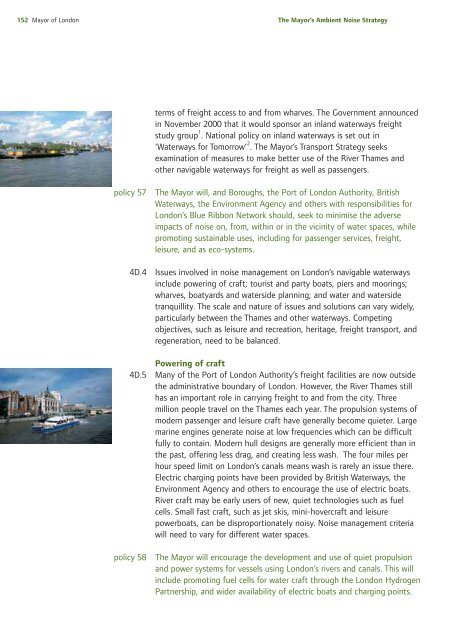The Mayor's Ambient Noise Strategy - Greater London Authority
The Mayor's Ambient Noise Strategy - Greater London Authority
The Mayor's Ambient Noise Strategy - Greater London Authority
Create successful ePaper yourself
Turn your PDF publications into a flip-book with our unique Google optimized e-Paper software.
152 Mayor of <strong>London</strong><br />
<strong>The</strong> Mayor’s <strong>Ambient</strong> <strong>Noise</strong> <strong>Strategy</strong><br />
terms of freight access to and from wharves. <strong>The</strong> Government announced<br />
in November 2000 that it would sponsor an inland waterways freight<br />
study group 1 . National policy on inland waterways is set out in<br />
‘Waterways for Tomorrow’ 2 . <strong>The</strong> Mayor’s Transport <strong>Strategy</strong> seeks<br />
examination of measures to make better use of the River Thames and<br />
other navigable waterways for freight as well as passengers.<br />
policy 57<br />
<strong>The</strong> Mayor will, and Boroughs, the Port of <strong>London</strong> <strong>Authority</strong>, British<br />
Waterways, the Environment Agency and others with responsibilities for<br />
<strong>London</strong>’s Blue Ribbon Network should, seek to minimise the adverse<br />
impacts of noise on, from, within or in the vicinity of water spaces, while<br />
promoting sustainable uses, including for passenger services, freight,<br />
leisure, and as eco-systems.<br />
4D.4 Issues involved in noise management on <strong>London</strong>’s navigable waterways<br />
include powering of craft; tourist and party boats, piers and moorings;<br />
wharves, boatyards and waterside planning; and water and waterside<br />
tranquillity. <strong>The</strong> scale and nature of issues and solutions can vary widely,<br />
particularly between the Thames and other waterways. Competing<br />
objectives, such as leisure and recreation, heritage, freight transport, and<br />
regeneration, need to be balanced.<br />
Powering of craft<br />
4D.5 Many of the Port of <strong>London</strong> <strong>Authority</strong>’s freight facilities are now outside<br />
the administrative boundary of <strong>London</strong>. However, the River Thames still<br />
has an important role in carrying freight to and from the city. Three<br />
million people travel on the Thames each year. <strong>The</strong> propulsion systems of<br />
modern passenger and leisure craft have generally become quieter. Large<br />
marine engines generate noise at low frequencies which can be difficult<br />
fully to contain. Modern hull designs are generally more efficient than in<br />
the past, offering less drag, and creating less wash. <strong>The</strong> four miles per<br />
hour speed limit on <strong>London</strong>’s canals means wash is rarely an issue there.<br />
Electric charging points have been provided by British Waterways, the<br />
Environment Agency and others to encourage the use of electric boats.<br />
River craft may be early users of new, quiet technologies such as fuel<br />
cells. Small fast craft, such as jet skis, mini-hovercraft and leisure<br />
powerboats, can be disproportionately noisy. <strong>Noise</strong> management criteria<br />
will need to vary for different water spaces.<br />
policy 58<br />
<strong>The</strong> Mayor will encourage the development and use of quiet propulsion<br />
and power systems for vessels using <strong>London</strong>’s rivers and canals. This will<br />
include promoting fuel cells for water craft through the <strong>London</strong> Hydrogen<br />
Partnership, and wider availability of electric boats and charging points.
















